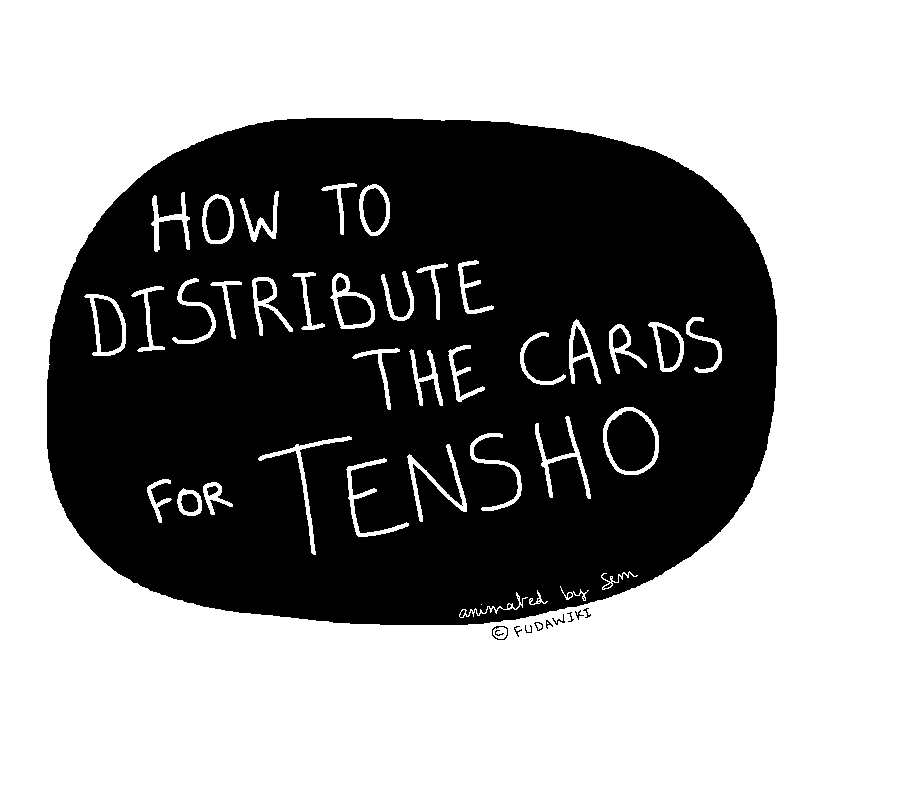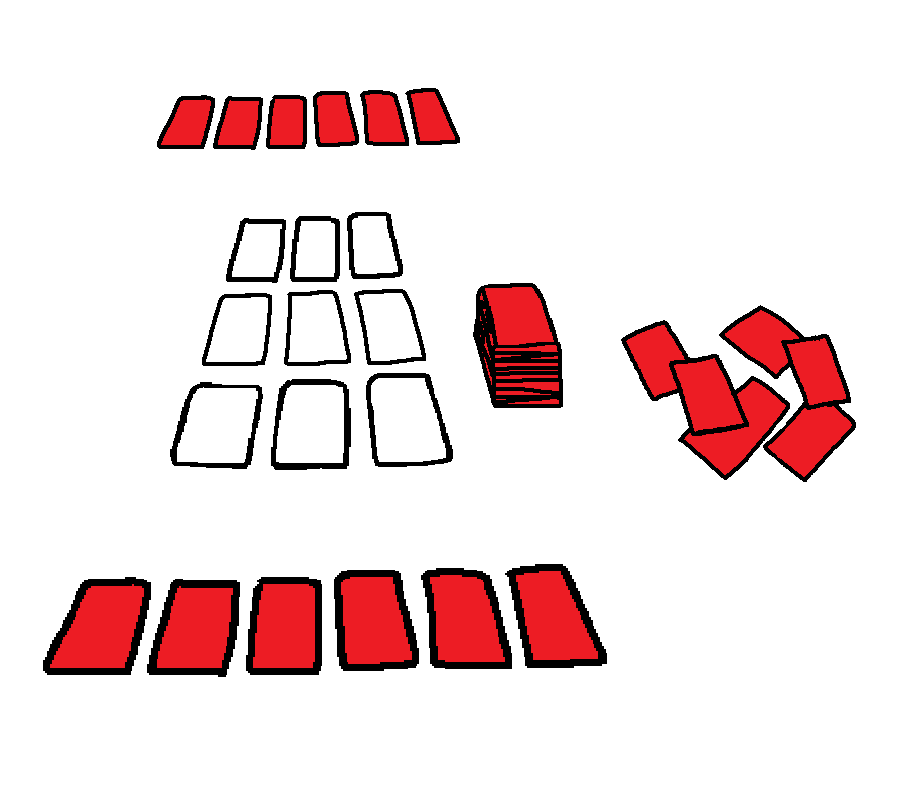Tensho is a hanafuda game for two players, likely originating in the Nagoya region of Japan. Like some other games from the area, it is played without the 3 ![]() Paulownia Chaff, and it uses an alternate suit order shared with Hon-Bana, Hiyoko, and Isuri. Other notable features are its two different sets of yaku, only one of which is used each round, and its two-tiered tie-breaking arbitration.
Paulownia Chaff, and it uses an alternate suit order shared with Hon-Bana, Hiyoko, and Isuri. Other notable features are its two different sets of yaku, only one of which is used each round, and its two-tiered tie-breaking arbitration.
The game was considered as the predecessor to the games Mekuri and Hana-Awase.
This game was originally played using a mekurifuda deck called Ise; click here to see the rules using the Ise deck.
¶ Setup
First, prepare the deck by removing the three ![]() Paulownia Chaff from a standard hanafuda deck, leaving a 45-card deck. Choose the initial dealer in whatever manner preferred. In subsequent rounds, the winner of the previous round becomes the new dealer. Player should also agree on the duration of the game - some common options are 3, 6, or 12 rounds.
Paulownia Chaff from a standard hanafuda deck, leaving a 45-card deck. Choose the initial dealer in whatever manner preferred. In subsequent rounds, the winner of the previous round becomes the new dealer. Player should also agree on the duration of the game - some common options are 3, 6, or 12 rounds.
¶ Yaku Selection
One unique characteristic of Tensho is that it has two sets of yaku, only one of which is chosen for use each round. This decision should be made prior to the deal, before either player has any information. If the players cannot agree on a set to use, the choice defaults to the dealer’s preference.
¶ Distributing the Cards

The dealer shuffles the deck. There is a specific method of dealing the cards associated with this game:
- Place 3 cards face down next to each other on the field.
- Deal 4 stacks of 3 cards each, face down in the four corners around the field.
- Place another 3 cards face down on the field in a row below the first 3.
- Add another 3 cards to each of the existing stacks in the corners of the field.
- Put 3 final cards face down onto the field in a third row, for a total of 9 cards face down on the field in a 3 by 3 grid.
- Finally, add 3 more cards each to 2 of the stacks in the corners of the field.
- The remaining 6 cards are set aside as “dead cards” this round and will not be used to play Tensho, but may be used to play Tokotoko.
- The dealer chooses one of the stacks of 6 cards to become his hand; the other becomes the opponent’s hand.
- The 2 stacks of 9 cards are combined to become the draw pile for the round.
- Play Shoniban if desired, and reveal the 9 cards on the field.
If this is too convoluted, the important thing is to ensure that each player has a 6-card hand, and that there are 9 cards face up on the field, 6 “dead cards” set aside, and an 18-card draw pile.
Expected result:
¶ Gameplay
Gameplay proceeds in much the same manner as other fishing games, with the dealer playing first. However, if there are 3 cards of the same suit on the field at the beginning of the game, the dealer may capture two of those cards, and will instead play second.
On your turn, add one card from your hand to the field, followed by the top card of the draw pile, matching each of them by suit with a card on the field if possible. If a pair is made, capture those cards and add them to your scoring area.
Note that since the ![]() Phoenix is the only
Phoenix is the only ![]() Paulownia card used, the player who plays or draws this card simply places it directly in their own scoring area without first sending it to the field. If the
Paulownia card used, the player who plays or draws this card simply places it directly in their own scoring area without first sending it to the field. If the ![]() Phoenix is dealt to the field at the beginning of the game, neither player can capture it.
Phoenix is dealt to the field at the beginning of the game, neither player can capture it.
Play continues back and forth with each player repeating the above steps in turn, until either one player has collected an instant-win yaku, or both players have run out of cards.
¶ End of Round
The round ends as soon as a player has captured one of the “Instant Win” yaku. Otherwise, players continue taking turns until they have both exhausted their hands, at which point they add up the points for all yaku they have collected. The player who has earned the most points from yaku is declared the winner of the round.
¶ Breaking Ties
If, however, neither player has completed any yaku, or otherwise their yaku scores are the same, then the player who has captured the most Chaff cards wins.
If players are tied with regards to both yaku and number of Chaff captured, each player totals the sum of points for their respective captured cards, according to the Card Values chart below.
¶ Yaku
Note that many of the yaku names only make sense in the context of the Nagoya suit order, with 馬 (ma, “horse”) representing the value “11” and キリ(kiri, “king”) representing “12” - these terms are remnants from when the game was originally played with a mekurifuda deck containing these “court” cards; it was only later that the game was adapted to hanafuda.
Many of the non-numeric yaku names may also be numeric puns - for instance, yashima may be interpreted as ya shima, “eight islands,” or as ya-shi-ma “eight-four-horse.”
As in many other hanafuda games, the point values for each yaku may differ from source to source; the values demonstrated here reflect those used in the 1927 gambling book.
¶ Both Sets
The first 12 yaku in Tensho are common to both sets of yaku, and thus are always valid. There are two other yaku (Front Elder and Back Elder) that technically fall into this category, but they are listed separately since they change values depending on which yaku set is selected.
* Some sources use the ![]() Rain Man instead of the
Rain Man instead of the ![]() Swallow in these two yaku.
Swallow in these two yaku.
** Some sources give these yaku as “Ten Nine Twelve” with ![]() Chrysanthemum cards replacing the
Chrysanthemum cards replacing the ![]() Peony shown here.
Peony shown here.
¶ Set 1 Only
Set 1 - 七分役 [しちぶやく, shichi-bu yaku] contains 3 more yaku than Set 2, and emphasizes cards in the ![]() Peony,
Peony, ![]() Cherry Blossom, and
Cherry Blossom, and ![]() Wisteria suits, in that order.
Wisteria suits, in that order.
¶ Set 2 Only
Set 2 - 半役 [はんやく, han yaku] has fewer yaku total, but has one more yaku that grants an instant victory. It has many yaku featuring cards of the ![]() Maple suit, followed by
Maple suit, followed by ![]() Susuki Grass and
Susuki Grass and ![]() Chrysanthemum.
Chrysanthemum.
¶ Card Values
Under most circumstances, only yaku are counted, and card values are not calculated. However, in the case that both players have identical yaku scores and equal numbers of captured Chaff cards, the tie may be broken and the winner determined by the player with the greater sum of points for all captured cards.
| Card Value | Cards |
|---|---|
| 15 | |
| 12 | |
| 11 | |
| 10 | |
| 9 | |
| 8 | |
| 7 | |
| 5 | |
| 4 | |
| 3 | |
| 1 | The |
¶ Bibliography
- “Tensyo” Hanafuda Tenkomori for Dad, Unbalance, 2010.
- Johnson, Jason, and Antonietta Fazio-Johnson. Hanafuda Games, Hanami ed., IndianWolf Studios, 2017.
- Tobaku Ni Kansuru Chōsa. vol. 121, Shihōshō Chōsaka, 1927, National Diet Library, dl.ndl.go.jp/info:ndljp/pid/1269696. pp. 8-13, 52-58.
- https://web.archive.org/web/20050219222956/http://hana.kirisame.org/tensho.html
